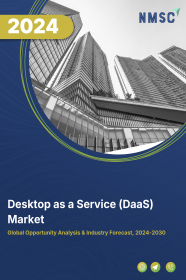
Desktop as a Service (DaaS) Market by Deployment (Public Cloud, Private Cloud, and Hybrid Cloud), by Enterprise Size (Small and Medium-Size Enterprises and Large Enterprises), by End-user (BFSI, IT and Telecom, Government, Media and Entertainment, Education, Healthcare, Manufacturing, and Others)- Global Opportunity Analysis and Industry Forecast 2022-2030
Market Definition
The Desktop as a Service (DaaS) Market was valued at USD 4.42 billion in 2021 and is predicted to reach USD 29.82 billion by 2030 with a CAGR of 23.9% from 2022-2030. DaaS is a cloud computing service that provides users with access to a virtual desktop environment.
It provides a secure, hosted desktop environment with pre-installed applications, data storage, and access to the web. Desktop as a service reduces the cost of ownership, reduces the complexity of managing desktops, and provides a more secure environment than traditional desktop environments. It can also be used to deploy applications to multiple devices and provide a consistent experience across different devices.
Market Dynamics and Trends
The rising adoption of remote and mobile work in organizations to improve customer experience is boosting the growth of the DaaS market. Also, the DaaS solution provides an additional layer of security to an organization’s existing infrastructure by storing data in the cloud which is becoming increasingly important due to rising organizational security concerns, and this is fueling the market demand.
Moreover, it reduces the capital and operational costs of an organization as compared to traditional desktop computing, thereby fuelling the growth of the desktop as a service market. With desktop as a service, organizations can use their existing network infrastructure to access data wherever required.
The high network bandwidth requirement coupled with latency and security issues is expected to restrain the growth of the desktop as a service market. On the other hand, factors including the rising digitalization, adoption of cloud computing solutions, and availability of high internet speed at a very reasonable price are the factors that are expected to create ample growth opportunities for the desktop as a service market in the coming future.
Market Segmentation and Scope of Study
The global desktop as a service market is segmented based on deployment, enterprise size, end-user, and geography. Based on deployment, the market is classified into public cloud, private cloud, and hybrid cloud. Based on the enterprise size, the market is segmented into small and medium-size enterprises and large enterprises. On the basis of end-user, the market is categorized into BFSI, IT and telecom, government, media and entertainment, education, healthcare, manufacturing, and others. Geographical breakdown and analysis of each of the aforesaid classifications include regions comprising North America, Europe, Asia-Pacific, and RoW.
Geographical Analysis
North America dominated the global desktop as a service market in 2021 and is potently expected to remain dominant in the market throughout the forecast period. This is attributed to the increasing adoption of remote working by organizations, which resulted in an increase in demand for cloud-based services including desktop-as-a-service solutions.
Also, the key market players in the region such as Amazon Web Services, IBM Corporation, Dizzion Inc., and Microsoft Corporation among others are undertaking various strategic market initiatives to remain dominant in the industry. This is further accelerating the growth of the desktop as a service market in the region.
For instance, in July 2021, Microsoft launched Windows 365 enabling businesses to easily access a Windows 10 desktop from the cloud. Also, in April 2021, Dizzion, Inc. launched an advanced managed desktop offering based on IBM cloud to assist enterprises in managing the workforce by making it easier for employees to work remotely in a collaborated and secured environment. In conclusion, the increasing adoption of remote work and the strategic market initiatives by key players in North America are expected to drive the growth of the desktop-as-a-service market in the region in the forecast period.
Asia Pacific is expected to witness substantial growth in the global desktop as a service market during the forecast period, owing to the growing adoption of cloud-based services across industries including IT, manufacturing, BFSI, and healthcare in developing economies such as India, China, and South Korea.
Moreover, the growing technological advancements such as the integration of AI and machine learning to offer the greatest degree of application compatibility and personalization along with business expansion and new launches by global players such as Fujitsu are further boosting the desktop as a service market in the region.
For instance, in October 2022, Fujitsu launched “Data e-TRUST” as a new service function for “Fujitsu Computing as a Service” (CaaS) in Japan to accelerate secure data exchange across industries. In conclusion, the Asia Pacific region is expected to experience significant growth in the desktop-as-a-service market due to the growing adoption of cloud-based services and technological advancements, driven by key players such as Fujitsu.
Competitive Landscape
The desktop as a service market includes several market players such as Amazon Web Services, VMware, IBM Corporation, Microsoft Corporation, NetApp, Cloudalize, Fujitsu, Citrix Systems, Cisco Systems, Inc., and Dizzion Inc. among others. These market players are adopting various strategies such as innovation and collaboration to maintain their dominance in the global desktop as a service market.
For instance, in January 2022, Microsoft launched Azure virtual desktop support, a desktop and app virtualization service that runs on the cloud with the ‘Trusted Launch’ protection. It aims to improve the security posture of virtual machines by protecting against advanced and persistent attack techniques.
Also, in October 2021, Citrix Systems, Inc. collaborated with Google Cloud to deliver hybrid work for enterprise customers, including a new DaaS offering on Google Cloud. Moreover, in May 2022, NetApp launched a cloud-based DaaS solution named Spot PC. Through this launch, the company aims to provide optimized security and automation for public cloud services.
Key Benefits
-
The desktop as a service market report provides a quantitative analysis of the current market and estimations through 2022-2030 that assists in identifying the prevailing market opportunities to capitalize on.
-
The study comprises a deep dive analysis of the desktop as a service market trend including the current and future trends for depicting the prevalent investment pockets in the market.
-
The information related to key drivers, restraints, and opportunities and their impact on the desktop as a service market is provided in the report.
-
The competitive analysis of the market players along with their market share in the desktop as a service market
-
The SWOT analysis and Porter’s Five Forces model are elaborated in the study.
-
Value chain analysis in the market study provides a clear picture of the stakeholders’ roles.
Key Market Segments
By Deployment
-
Public Cloud
-
Private Cloud
-
Hybrid Cloud
By Enterprise Size
-
Small and Medium-Size Enterprises
-
Large Enterprises
By End-User
-
BFSI
-
IT and Telecom
-
Government
-
Media and Entertainment
-
Education
-
Healthcare
-
Manufacturing
-
Others
By Geography
-
North America
-
U.S.
-
Canada
-
Mexico
-
-
Europe
-
UK
-
Italy
-
Germany
-
Spain
-
Netherlands
-
Rest of Europe
-
-
Asia-Pacific
-
China
-
Japan
-
India
-
Australia
-
South Korea
-
Taiwan
-
Vietnam
-
Rest of Asia Pacific
-
-
RoW
-
Latin America
-
Middle East
-
Africa
-
Key Players
-
Amazon Web Services
-
VMware
-
IBM Corporation
-
Microsoft Corporation
-
NetApp
-
Cloudalize
-
Fujitsu
-
Citrix Systems
-
Cisco Systems Inc.
-
Dizzion Inc.
REPORT SCOPE AND SEGMENTATION:
|
Parameters |
Details |
|
Analysis Period |
2021–2030 |
|
Base Year Considered |
2021 |
|
Forecast Period |
2022–2030 |
|
Market Size Estimation |
Billion (USD) |
|
Market Segmentation |
By Deployment (Public Cloud, Private Cloud, Hybrid Cloud) By Enterprise Size (Small and Medium-Size Enterprises, Large Enterprises) By End- User (BFSI, IT and Telecom, Government, Media and Entertainment, Education, Healthcare, Manufacturing, Others) |
|
Geographical Segmentation |
North America (U.S., Canada, Mexico) Europe (Germany, UK, Spain, Italy, Netherlands, Rest of Europe), Asia-Pacific (Australia, China, India, Japan, South Korea, Vietnam, Taiwan, Rest of Asia-Pacific), Rest of the World (Latin America, Middle East, Africa) |
|
Companies Profiled |
Amazon Web Services, VMware, IBM Corporation, Microsoft Corporation, NetApp, Cloudalize, Fujitsu, Citrix Systems, Cisco Systems, Inc., and Dizzion Inc. among others. |




















 Speak to Our Analyst
Speak to Our Analyst

























